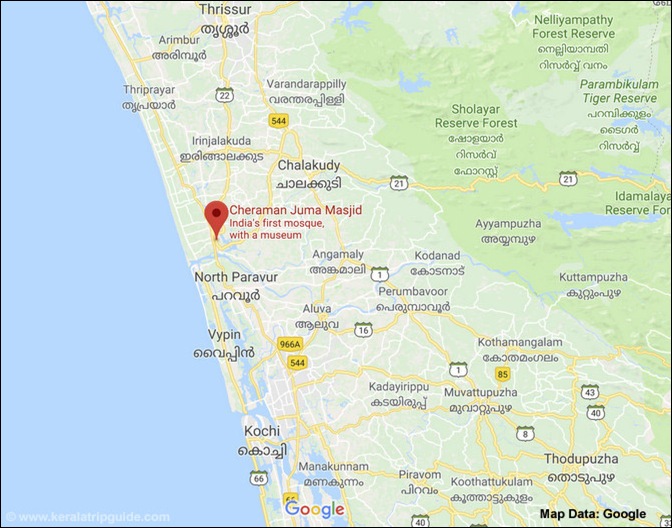Cheraman Juma Masjid (Cheraman Mosque)
Introduction
Cheraman Juma Masjid
Cheraman Juma Masjid is an old mosque located in Kodungallur taluk of Thrissur district in Kerala. It is considered to be the first mosque in India and one of the oldest mosques in the world. Some believe that the mosque is built as early as AD 629 (very close to origins of Islam)! If true, this would make the mosque one of the important archeological buildings in India.
India and the Arabian Peninsula had trade relations going back to thousands of years. Kodungallur was an active sea based trade route to the Arabian Peninsula. Some believe that the ancient urban centre of Muziris mentioned in ancient texts is located somewhere in Kodungallur. The Cheraman mosque is believed to be built by Malik Deenar, one of the earliest Arabic missionary of Islam. It is probably named after Cheraman Perumal, the Chera ruler of the old Kodungallur kingdom.
The original mosque was built in traditional Kerala architectural style and it even has a traditional brass lamp and pond seen in most temples of the time. The ancient oil lamp is kept burning and believed to be over a thousand years old. People from all religions bring oil for the lamp as an offering. The lamp and pond is still preserved but the mosque structure had undergone a number of renovations, destroying most of the original style of the structure. Only the front structure has any resemblance to the original structure.
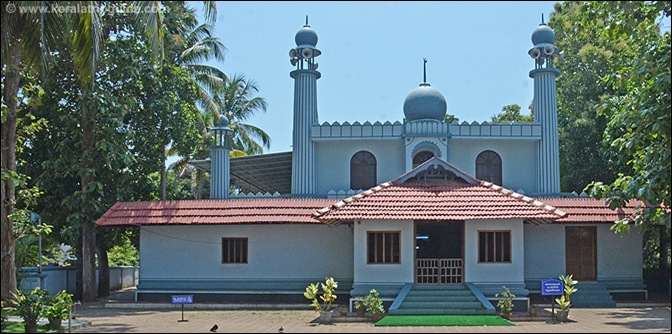
Historical Background of Cheraman Mosque
There is little historical evidence to the origins of Cheraman Mosque. Most of what we know are from the oral traditions. The original mosque had a temple like foundation similar to what is usually seen in 11th century architectural style. It is also quite possible that this structure itself is part of a renovation undertaken sometime in 11th century.
There are a number of stories regarding the construction of the mosque. The most commonly told story is as follows. This story is also featured on the official booklet available for Rs.20 from the Cheraman mosque office,
In sixth century, Cheraman Perumal was the Chera king ruling parts of central Kerala with Kodungallur as the capital. One day he saw an unusual dream of the moon splitting into two at the horizon. No one among the royal astrologers could give a reasonable explanation for the dream. He mentioned the dream to a group of Arabic sailors going to Ceylon. They explained that what he saw could be the miracle that the Prophet Muhammad performed in Saudi Arabia. Cheraman Perumal was convinced about this interpretation and decided to take a trip to Mecca. There he met the prophet and embraced Islam.
Cheraman Perumal spent sometime in Mecca and fell ill and died in Oman. Before his death, he is said have written letters to his caretakers back at home. It is said that Arabic Islamic missionary, Malik Deenar and his companions carried these letters to Kodungallur. They were given permission by the local rules to build mosques around Kodungallur. The first mosque in India was thus constructed at Kodungallur in AD 629 and Malik Deenar himself was the first Ghazi of this Cheraman Juma Masjid. It is believed that later his son (or relative?) Habib Bin Malik became the Ghazi of the mosque. Many believe that the old tombs now at Cheraman Mosque belong to Habib Bin Malik and his wife Khumarriah.
Since then the Cheraman mosque has undergone a number of renovations. It is believed that major renovations were done in 11th, 14th and 15th century. The recent renovations was done in 1974, 1984, 1994 and 2001. The minarets in the current structure was added sometime in 1984 (which has drastically changed the style of the mosque).The front part of the mosque with its wood roofing is relatively untouched during renovations. Following is an old photograph of the mosque taken before 1950.
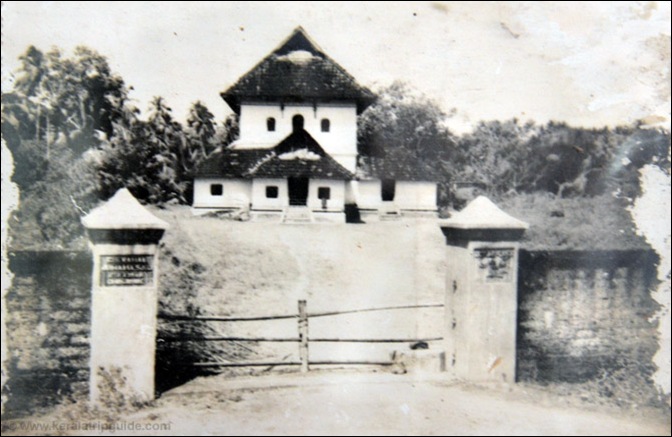
President A. P. J. Abdul Kalam visited the mosque in 2005. In April 2016, Prime Minister Narendra Modi gifted a gold-plated replica of the Cheraman Juma Masjid to the Saudi King Salman bin Abdulaziz Al Saud.
The Masjid traditionally has welcomed people of all faiths and non-Muslim communities participate in the Iftar offerings during the month of Ramzan. It is a testament to the secular credentials of the area that even non-muslims conduct Vidhyarambham (traditional Hindu initiation ceremony to the world of letters) of children at the mosque.
Details of Cheraman Mosque
Cheraman mosque was designed and constructed based on the traditional Hindu architectural style of Kerala. Mosques all over the world usually face the direction of Mecca in Saudi Arabia, but Cheraman mosque faces east following the Hindu temple tradition. The main section of the mosque (located at the rear of the structure) consists of the Mihrab (people offer prayer facing this wall), Minbar (the raised platform from where imam delivers sermons) and a large traditional brass lamp hanging from the ceiling with inscriptions in Malayalam and Arabic. The Minbar is made of rosewood and has multiple steps and is covered in wooden structures with intricate carvings. The Mihrab has a semi-circular arch with white, blue and golden colors. There are ancient wall writings and beautiful wood work inside the mosque.
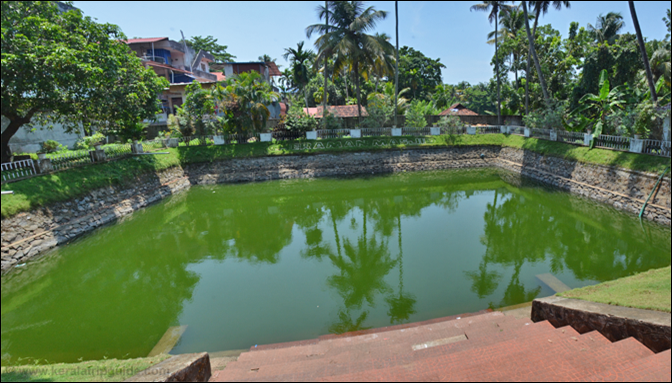
There is large pond behind the mosque again underlying its construction based on ancient Kerala traditions. This pond is currently used for water conservation in the area. The mosque also has a large population of native pigeons.
Getting to Cheraman Mosque
Cheraman mosque is located on the Kerala state highway 51 which connects Kodungallur to Kodakara. The nearest railway station is Irinjalakkuda (20KM), but only a few trains stop there. The major nearby railway stations are Angamaly (27KM) and Aluva (26KM). The nearest airport is Nedumbassery (Cochin Airport) located around 25KM away.
If you are visiting the place by bus, you can take a KSRTC bus to Kodungallur and then take a local bus to the mosque. Since the place is close to Kodungallur (2KM) you can also take an autorickshaw from the Kodungallur town. If you plan to stay to explore other areas such as the Muziris Heritage Project, good hotels are available near Kodungallur town.
Visitor’s Guide to Cheraman Mosque
Park your car at the paid parking lot near the Islamic history museum. It is large and if you are lucky, you will be able to find a parking area with some shade. After paying the parking fee, proceed to the Islamic history museum. There is a small entry fee (Rs.5) to the museum. The museum is very small with some historical artifacts and probably the only significant item is the large replica of the original Cheraman mosque. You can easily spend half an hour here exploring various exhibits. After the museum visit, proceed to the mosque pond by going around the museum. A modern, well maintained toilet complex is located on the left of the footpath (behind the museum) leading to the mosque pond. After visiting the pond, walk toward the front of the mosque complex.
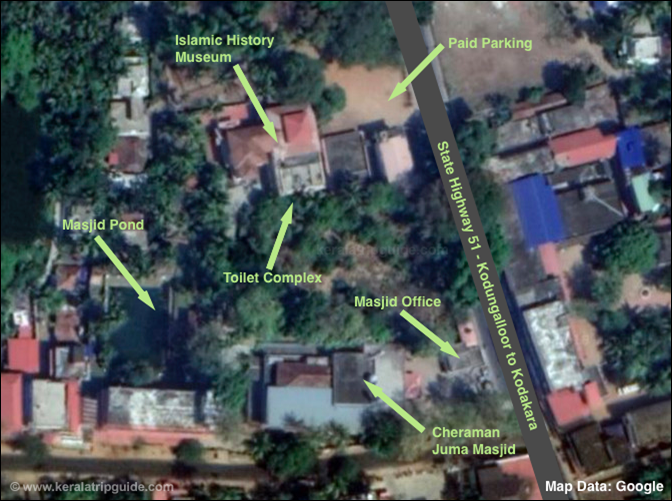
The mosque office is located adjacent to the main road. If you are planning to take photos inside the mosque, please visit the office and take permission. You can also get an official booklet on the Cheraman Masjid from the office for Rs.20. The front door to the mosque is usually locked. To see the hanging lamp and the main structure, go to the right side of the mosque (Please note that this area is not open for women). Clean your legs with the water from the tank and then proceed to the main mosque area.
Islamic History Museum at Cheraman Mosque
There is a small museum on the northern side of the Cheraman Juma Masjid. They charge an entry fee of Rs.5 to the museum which is just one small room. This museum is now known as Islamic history museum probably renamed as part of the Muziris Heritage Project. The official opening hours are from 10AM to 5PM (the mosque office is open from 8:30AM to 7:30PM).
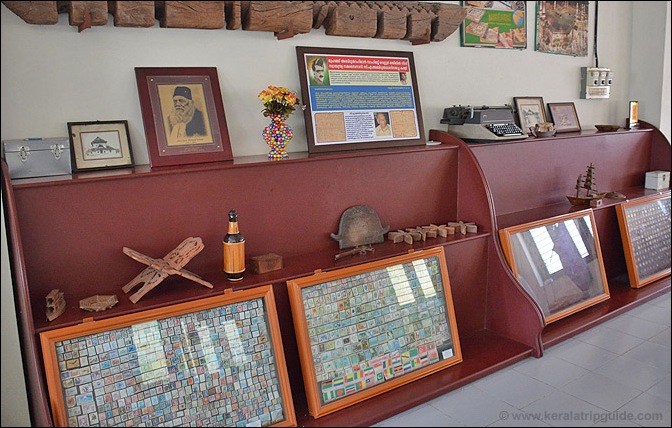
There are only a handful of interesting historic artifacts here. Many things in the collection such as the stamps have little historic significance as far as the mosque is concerned. The main attraction is the large size replica of the Cheraman Juma Masjid before the minarets were added to the structure. There are also a couple of photos of the old mosque, an old gramophone, a giant set of old keys and some news clippings.
My Visit to Cheraman Mosque
I had gone to the Cheraman mosque on a Monday during summer. Since Monday is holiday for the Muziris heritage project and museums, no tourists were at the mosque or the museum nearby. I reached the mosque around 1pm. After parking, I found the museum to be closed. When I asked the security, he called the caretaker handing him the keys to the museum. I spent around half hour in the museum and I was the only visitor at the time. There were only few items with any historic value. I saw a audio visual kiosk which was switched off. Later a bus with a large group of religious tourists came to the place. It was getting crowded at the museum and hence I proceeded to the Cheraman mosque.
I went around the museum toward the mosque pond. After spending few minutes at the pond I walked towards the front of the mosque. There was a large group of pigeons in front of the mosque and the security staff stationed there was feeding it. I asked him whether I can take photos and he told me that I need permission from the office to take photos inside the mosque. When I asked the guy at the office he told me that his boss is not there to give the permission. I left the place after visiting the mosque and taking a few photographs of the outside structure. Following is the cover of the information booklet available at the mosque,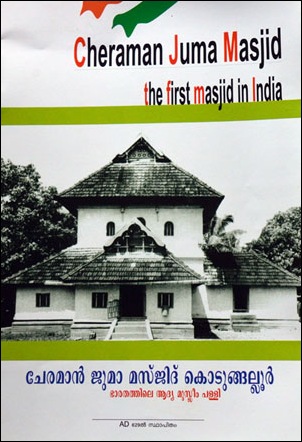
Summary
Cheraman Juma Masjid is probably the second oldest mosque in the world. If you are in Kerala as a tourist and if history is something that excites you, don’t miss the ancient Cheraman Juma Masjid in Kodungallur. Spend an hour here and marvel at the fact that the world’s second largest religion started its journey in India from this small place around 1400 years ago!
There are a number of interesting historic places near Cheraman Juma Masjid. These include Cheraman Parambu, Muziris boat jetty, Munambam beach, Munakkal beach, Kottappuram fort (also known as Muziris fort or Kodungallur fort), Kodungallur Bhagavathy Temple, Marthoma Church, Maliankara bridge and a number of interesting museums such as Kerala Jews history museum, Paliam Palace museum, Paliam Nalukettu museum, Sahodaran Ayyappan museum, Abdul Rahman Sahib museum and Kesari Balakrishna museum. For more details about these places, please visit the Muziris Heritage Project website.
Additional Resources
April 19, 2018 | Posted in Travel Reviews No Comments » | By Jayson

